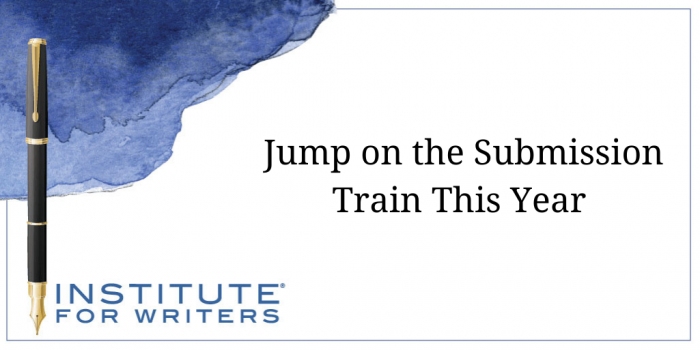1000 N. West Street #1200, Wilmington, DE 19801
© 2024 Direct Learning Systems, Inc. All rights reserved.
Beginning Tuesday, July 22, 2025 at 10 PM CT through Wednesday, July 23, 2025 at 4 AM CT, we will be performing scheduled maintenance to update our website.

The start of a new year is the perfect time for writers to assess their productivity goals. Many will challenge themselves by making adjustments to their writing schedule; some writers vowing to work nonstop for a solid hour each day, others pledging a daily goal of at least a thousand words.
Making a writing plan for 2021 is important, but this may be the year you also decide to get serious about submitting all that good stuff you create. If being published is your goal, think about what has been stopping you from sending out your work regularly. The students I work with will most often say they fear rejection. Others mention being intimidated by the image of an editor reading and possibly not liking their manuscript. Still others admit they just don’t know how to begin.
Make 2021 the year to create a submissions plan so you can confidently get your writing into editors’ hands. With that in mind, let’s tackle each potential roadblock head-on.
 Lose the Fear of Rejection
Lose the Fear of RejectionFace it, your submission will probably not be accepted. Yes, it is most certainly terrific and a manuscript you endlessly revised, one you thought about constantly, and then finally sent out to the perfect market. You got a “No, thank you” email a few weeks or months later, or maybe you never heard anything back at all. Most magazines publish just 1% of the unsolicited work sent to them—often less—and receive hundreds of postal and electronic submissions each month. With book publishers that percentage is even less.
Your story or article may not be accepted for dozens of reasons: the editor may have been looking for a specific topic when he received your work; he may have a backlog of manuscripts and is not interested in looking at anything right now; or in some cases he may not have read past the cover letter, which summarized a manuscript he either had no interest in or already had something similar in his files. The submission may not have been the type of piece the publisher publishes or (don’t let this happen) the manuscript or article—or the letter itself—had spelling, grammar, or punctuation errors.
Submit your best, error-free work, realizing that the reasons for its rejection are otherwise beyond your control. By not accepting your manuscript, the editor is simply indicating that your manuscript or article is not something she can use at this time. Once you vow not to take a rejection personally, it makes submitting a breeze.
I have met plenty of editors at writers’ conferences, book events, and writing courses I have attended and followed others editors on social media. It is easy to realize they are just regular folks with a pretty cool job—don’t let them intimidate you. Submit to editors with confidence, keeping in mind that these days they are probably working from a corner of their cramped apartment, wearing sweatpants and slippers rather than a power suit.

Book editors are in a similar boat. They can only publish so many books per year. They are limited by their printing budget as well as their marketing budget. They need books that fit within the tone and quality of their imprint, but they can’t publish the same story every time. If your manuscript is too close to one they already have on their list, they may pass on your book in favor of one that fits in a different spot on their list.
A good place to start your submissions journey is with a market guide. (If you also write for the children’s or YA market, check out the Institute’s Market Guides for Children’s Writers. They showcase publishers that accept manuscripts in both children’s and adult markets.) Carefully read through each entry and highlight those that seem to be possible places to explore further. Go to those markets’ websites and search “Submission Guidelines.”

Study a magazine’s back issues to see the type of pieces each publishes, recognizing that every magazine has its own personality and style. A manuscript that seems to work well for one magazine will probably have to be revised to send to another market. By somewhat tailoring your writing to the general style of a magazine, you can increase the likelihood of your manuscript being read and considered.
If you’re submitting to book publishers, be sure to study their back list to see if your manuscript fits within their theme and style. No sense sending your romance novel to a publisher that only publishes thrillers and mysteries. Researching publishers also gives you a chance to see the quality of their work and how your book would be marketed if they accepted it.
Use the early weeks of this year to craft a submissions plan, then vow to stick to it. In our next blog post, we’ll discuss where to find markets and more about getting your submissions out and keeping track of them.
Susan Ludwig, MA, has been an instructor with the Institute of Children’s Literature for over 15 years. Susan’s writing credits include teacher resource guides, English language learner books, and classroom curriculum for elementary through high school students. A former magazine editor, she assesses students’ written essays as a scoring director for the SAT exam. When she is not writing or working, she is usually found cooking or curled up with a good book.
1000 N. West Street #1200, Wilmington, DE 19801
© 2024 Direct Learning Systems, Inc. All rights reserved.
1000 N. West Street #1200, Wilmington, DE 19801
© 2024 Direct Learning Systems, Inc. All rights reserved.
1000 N. West Street #1200, Wilmington, DE 19801
© 2024 Direct Learning Systems, Inc. All rights reserved.
1000 N. West Street #1200, Wilmington, DE 19801
© 2025 Direct Learning Systems, Inc. All rights reserved.
1000 N. West Street #1200, Wilmington, DE 19801
©2025 Direct Learning Systems, Inc. All rights reserved. Privacy Policy.
1 Comment